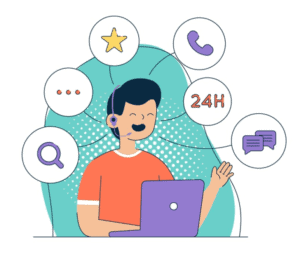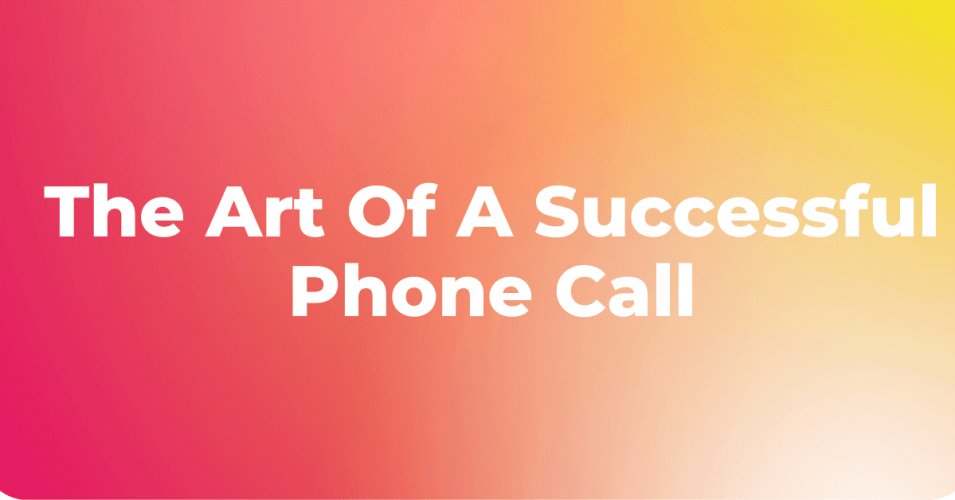For the modern call center agent, communication is everything. As a call center agent, you have the opportunity to create lasting relationships with your customers, and to earn their loyalty. But it takes more than just a friendly attitude to make that happen. It takes a willingness to learn how to use your voice as a tool, and how to structure a conversation in a way that puts the customer first.
When you’re running a call center, it can be difficult to know how to define success.
One way to think about it is First Call Resolution or FCR. The more problems you can solve for a client in a single call, the better. First Call Resolution (FCR) is defined as “the percentage of all calls resolved at the first point of contact without requiring additional time from support personnel,” and it’s key for any successful call center agent. How do you resolve issues during your first call? By becoming an expert in rhetoric and phonetic delivery. You can do this by learning how to use vocal pitches, word choices, breathing techniques, and even body language to convey friendliness and empathy—even when the customer is on the other end of the line.
But FCR isn’t the only measure of success. Another is rhetoric and phonetic delivery: are your agents saying the right things in a way that sounds good? There are entire books written on this subject—it’s a whole field of study!
And then there’s call openers and the 30-second rule. Calls need to start with something compelling enough to grab attention immediately, because it takes 30 seconds for someone to determine whether or not they like what they’re hearing.
Finally, there’s employee satisfaction and building call center culture. If your employees aren’t happy, their lack of enthusiasm will show in their calls—and you’ll have high turnover rates and lower productivity as a result.
In this article, we’ll discuss how you can improve your skills by focusing on five key concepts: rhetoric and phonetic delivery, the importance of call openers, the 30 seconds rule, employee satisfaction and building a call center culture. Use these tips and tricks as a methodology for future call center agent trainings.
First, how would you define a successful phone call?
First, let’s look at what makes a conversation successful. A conversation can be over within seconds, or it can go on for hours, but regardless of how long it lasts, it will be successful if both parties are satisfied with the outcome. When we talk about the art of a successful phone call in a call center, we’re usually looking at two key metrics: First Call Resolution (FCR) and Employee Satisfaction.
 With the rise of digital technologies and the options of using new communication channels, going back to the basics and training your call center agents on the methodology of a successful phone call might seem redundant. But in fact, a phone call is the first step into engaging the customer and getting his attention. We only get one first impression and in a call center, you have to make sure it’s a good one.
With the rise of digital technologies and the options of using new communication channels, going back to the basics and training your call center agents on the methodology of a successful phone call might seem redundant. But in fact, a phone call is the first step into engaging the customer and getting his attention. We only get one first impression and in a call center, you have to make sure it’s a good one.
You have the script ready, prospect list and customer base checked, but somehow, short attention span, distracted and skeptical customers are getting in the way of your most important metric: First Call Resolution.
First Call Resolution (FCR) refers to correctly diagnosing and resolving the customer’s issues at the initial point of contact. This customer relationship metric illustrates the quality of service that customers receive by measuring how often their issues are resolved at the first point of contact. Typically supported with a CRM or Case Management application.
A successful phone call requires focusing your campaign’s strategy on the client and attending to its needs and desires. Resolving the customer’s issues at the initial point of contact and having the call center agent perform effectively. From the first second until the end of the call will influence lower call volumes with shorter hold times, higher resolution, and lower churn. In the end, FCR is linked directly to enhanced agent performance and the quality of his phone calls.
By training the proper methodology and going back to the data to examine call center analytics from customer interactions, you can identify gaps in our processes and system.
Having a successful first outbound call and getting your message across or resolving your customer’s issue the first time a customer reaches out about the problem can make the difference between customer churn and customer retention.
Going deeper, we will analyze some of the tactics that focus on the quality of the call and reduce repeat calls to increase your metrics for call center efficiency.
Rhetoric and Phonetic Delivery
Rhetoric is the art and study of speaking and writing persuasively. It is a tool used not only in speeches, but its purpose is to inform, motivate and engage/persuade an audience.
There are some rhetoric situations that you can analyze in order to use rhetoric:
• Identify and analyze the context, the rhetorical situation you’re in
• Properly identify what needs to be communicated
• Use rhetorical tools to provide a strategic delivery
In the call center environment, the rhetoric will always be the agent, while the customer represents your audience, the people you’re trying to persuade. Before the actual call, determining your audience’s needs and pain points is crucial. Knowing the customer and gaining knowledge and expertise in the product/solution delivered and the way this will be presented on the call is an important aspect of call agent success and call strategy.
The Importance of Call Openers and the 30s Rule
A call opener is the opening line that provides value to the customer from first contact, keeping his attention and making them feel like they’ve received some benefit from not abandoning the call.
In the first 15 seconds of the call, when the agent still has his anonymity in the beginning, he can start off by introducing himself, mentioning the company’s and the customer’s name in a certain way that sounds great.
In a recent podcast episode, Richard Blank, CEO of Costa Rica’s Call Center, joined us to discuss what makes a successful phone call, insights into building a call center from the ground up and the pillars of strong culture and leadership. In addition, he is an expert trainer using rhetoric and phonetic delivery methodology and shared his ‘secret sauce’ used in his training.
Richard talks about a certain sort of balance in the call, followed through with phonetics, which is a term that represents ‘the sounds and other phenomena of speech.’ (Merriam-Webster Dictionary). In the call center world, phonetic is a great tool designed to clarify communication, improve customer service and is a fundamental part of a trainer’s toolkit.
Because during a phone call, you can’t read micro-expressions and body language, Richard is of the impression that our senses can be expanded, especially the hearing.
• Tone and intonation– represents the emotions coming out through speech. Phonetic indexing is one of two main methods used in speech analytics tools, and it can help detect emotions in the customer’s voice as well. For example, the tone of a call center agent should sound confident and empathetic. Intonation may affect the meaning of a whole phrase.
• Rate – how fast or how slow you speak.
• Pitch – represents the degree of highness or lowness of a tone. For example, when the agent sounds excited, they usually speak with a higher pitch. The main difference between pitch and tone is that the tone refers to the emotion behind the sound of the voice and the pitch to the frequency of the sound.
Combining phonetics and rhetoric delivery in call centers can prove to be very effective in coaching and has a lot more benefits that clearing out a conversation. The way we use our voice, can tell a lot about us and make us stand out and capture the client’s attention.
Personalizing the Conversation and the First 30 Seconds of a Call Center Phone Call
In an industry where the contact rate and First Call Resolution are among the most important KPIs for call center efficiency, the first 30 seconds are a determining factor between a successful phone call and losing the customer. The 30 seconds rule sets the primary perception in the customer’s mind.
They are significant, but the first 4 to 5 seconds are crucial to nail that initial piece and fully control the client’s short attention span. For an introduction, a good opener could be: Hello, [First Name], and not Hello, is this [First Name]? / Hello, I am looking for [First Name], is this him? A confident approach will end up getting better response and control.
Getting a ‘yes’ is the main focus of the call and building trust, confidence and authority with the customer are the main goals. A next step for the following first seconds could be confirming data and using many pronouns, for example: ‘I’m getting back to you about X.’ or ‘I want to confirm that you’re still interested in X product.’
The simple structure of a conversation is an introduction, a body, and a conclusion. Every call center department works for customer satisfaction and retention, therefore, active listening combined with name-dropping and use of pronouns in a call will translate into successful and effective interaction with the customer.
Employee satisfaction and building call center culture
After all, the call center agents are the ones directly interacting with your customers. Let’s suppose your employees are not motivated and engaged. In that case, they are often absent, and your call center agent turnover rate is high, it shows your company is not represented in every interaction they have with the customer. As a result, your overall company goals are taking a hit.
Aligning your company’s goals with employee performance can be one of the strongest tools to fight agent attrition in a high-churn field like customer support.
But the hope’s is not lost altogether. Improved onboarding, hiring profile with a culture fit and experience, gamification, cultivating flexibility, motivation through recognitions and awards will enhance call center retention and employee satisfaction top of mind.
Conclusion:
Investing time and effort in training and using tools like phonetics and rhetoric delivery, effective call openers, will ultimately enhance engagement and retention efforts.
Keeping employees motivated, engaged and elevating productivity reinforces the importance of a successful phone call driving better outcomes for companies and employees at the same time.

Andrei is an experienced marketing professional specializing in propelling growth for both B2B and B2C companies. Proficient in streamlining marketing operations and enhancing lead and customer experiences through SEO and marketing techniques.



